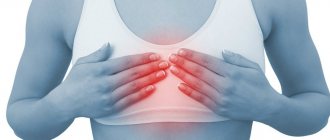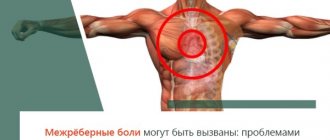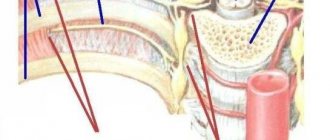When your chest hurts when breathing, the first thought that usually comes to mind is probably something wrong with your lungs.
The thoracic region contains more than just the lungs; but the fact that the pain syndrome is associated with breathing makes most people “blame” these paired organs for the unpleasant sensations when inhaling in the chest. But the lung tissue is not endowed with innervation (nerve endings) that would be capable of causing these sensations.
If there are no nerve endings in the lungs, what then provokes pain in the chest when inhaling, and why does the respiratory process affect the intensity of this pain? It turns out that pain in the chest when breathing can hide up to twenty different causes related not only to the respiratory, but also to the cardiovascular, nervous, and even digestive systems.
What can hurt your chest?
To understand why the chest hurts when you inhale, you will have to remember the anatomical structure and location of the organs in this part of the body. In the thoracic region are located:
- the heart, located in the cardiac “bag” - the pericardium;
- thoracic spinal column;
- trachea, branching in the lower part into bronchi;
- the aorta is the largest artery of the human body;
- lungs covered with pleura - a protective film that softens their friction against the costal arches.
In the lungs themselves there are bronchi and bronchioles, which are supplied with nerve cells, as well as the pleura and all the organs listed above.
Any pathology in the thoracic organs - pleura, trachea, heart or pericardium - accompanied by inflammation or irritation of pain receptors can cause pain in the chest when inhaling.
In addition, colic from an inflamed gallbladder or from the stomach or duodenum affected by an ulcerative process can radiate (spread) into it. Finally, for various reasons, the intercostal muscles may hurt from excessive stress (for example, pain during intense training or due to prolonged coughing) or the ribs themselves, if they have been injured. As you can see, there is a lot of pain in the chest and each case should be dealt with separately.
Treatment
It can be conservative or surgical, depending on the diagnosis. Some types of pathologies - for example, hepatitis - require long-term use of antibiotics and strong antiviral drugs, others are based on normalizing the diet and maintaining a healthy lifestyle. The specialists of the Energo clinic, who are true professionals in their field, will definitely identify the causes of back and chest pain, select a method that is suitable for you to solve the problem, and give useful recommendations regarding the period of recovery or remission in the case of a chronic illness.
Causes of pain when inhaling
What factors provoke the occurrence of pain in the chest when exhaling or inhaling? Provoking factors can be partly assumed by the nature of the pain. It’s not without reason that a doctor always asks questions like these to a person who is interested in why the chest hurts when inhaling:
- what kind of pain - sharp or dull, pressing;
- whether accompanied by cough or shortness of breath;
- Does it get worse with increased inhalation?
- Is it controlled by painkillers?
Such questions help a specialist recognize the clinical picture of the disease and guess whether he is dealing with an acute disease or a protracted pathological process. The reasons for these processes can be very different.
Neuralgia
What does the painful sensation indicate when you take a deep breath and your chest hurts? The connection between increased inhalation and chest pain is most often found in neuralgic conditions, that is, pain along a certain nerve. The mechanism for the appearance of this pain is clear:
- with a deep breath, the lung tissue expands, the intercostal muscles tense and all this begins to put pressure on the pain receptors located nearby;
- when a person is healthy, these receptors are not irritated and pain is not felt;
- if the roots of the intercostal nerves at the exit from the spinal column or the nerve endings in the intercostal muscles are compressed, pain will occur from the tension of these muscles when inhaling.
Neuralgic pain during a deep breath in the chest has the following characteristic feature - it is usually felt not only at the site of a pinched nerve, but also radiates to the scapula or collarbone, aggravated by pressure or sudden movements.
Neuralgia can develop due to:
- hypothermia;
- intensive training;
- unsuccessfully performed unusual movement;
- osteochondrosis.
Osteochondrosis is considered the most common cause of neuralgia, when it is painful to inhale and the chest hurts from any careless movement.
Respiratory system
The respiratory organs are also capable of causing pain in the chest when sighing if a pathological process develops in them. The most common cause of pain in the thoracic region is pleurisy, an inflammatory disease of the lining of the lungs.
This serous membrane has a two-layer structure, layered with mucus, which protects the pleura from friction.
If air enters this space, the pressure in the pleural cavity begins to increase, making it increasingly difficult for the lungs to expand when inhaling. This is why when you inhale, your chest hurts with pleurisy (and pneumothorax).
Another reason why chest pain occurs when you breathe is pneumonia, or pneumonia. Pain occurs when the inflammatory process spreads to the pleural area. A distinctive feature of the disease is fever, often a wet cough, which aggravates the pain. With pneumonia, the chest hurts when you inhale due to the expansion of the lungs, but it can also hurt when you exhale, since any movements of the intercostal muscles irritate the nerve receptors of the pleura.
In addition to the listed pathologies, chest pain when inhaling can occur due to:
- chronic bronchitis;
- tuberculosis (at a late stage);
- emphysema (late stage);
- pulmonary embolism (PE) and pulmonary infarction;
- malignant tumors;
- after an asthmatic attack;
- due to prolonged hacking cough with tracheitis or tracheobronchitis.
It is possible to establish the exact reason why there is pain in the chest area when inhaling only after undergoing special examinations in a medical institution. Perhaps it was caused by problems not in the respiratory system, but in the cardiovascular system.
The cardiovascular system
Sometimes, if your chest hurts when you inhale, this is a sign of pathologies of the heart and blood vessels. Which ones? Different variations of pain (in the sternum area, closer to the left side or radiating to the left extremities) often occur when:
- IHD, angina pectoris;
- pericarditis (inflammation of the “heart sac”);
- myocarditis (inflammation of the myocardium);
- cardiomyopathy (pathology of the heart muscle).
Pain in the chest due to heart pathologies is often aggravated by inhalation due to the fact that the expanding lungs affect the innervation of the heart membrane, which is already in an irritated state due to the disease. A feature of cardiac pain is its ability to radiate to the back, shoulder or arm.
Consequences of injury
Injuries to any segments of the thoracic region (clavicle, sternum, ribs) are also among the triggers for chest pain. Diagnosing such conditions is not difficult, since the patient, as a rule, himself turns to a traumatologist with complaints that when he inhales, he has pain in the chest area. And this is natural, because any movement, including breathing, causes injured bones to shift and irritate both their own pain receptors and nerve endings in nearby soft tissues.
There may also be hidden injuries, for example, a person may receive a rib fracture due to strong compression, which he may not pay attention to at first. There have been cases when the fact of a fracture was discovered only during an X-ray examination after the patient complained that his chest hurt when he inhaled strongly. This once again confirms the need for in-depth diagnostic studies to clarify the diagnosis.
Diagnostics
In case of pain in the chest on the right, a consultation with a therapist is indicated; in the future, the doctor can refer the patient to specialized specialists. A diagnostic search involves performing instrumental methods of visualizing the organs of the chest and abdominal cavities; to clarify the cause of thoracalgia, specific laboratory examination methods are performed. The most informative ones are:
- Radiography
. A plain radiograph of the lungs is recommended if pneumonia is suspected: attention is paid to focal heterogeneous darkening of the pulmonary parenchyma, expansion of the roots of the lungs and increased bronchial pattern. If a rounded shadow with a path to the root is detected at the apex of the lung on the right, a preliminary diagnosis of tuberculosis is made. - Ultrasonography
. If there is pain on the right side, not only in the chest, but also in the hypochondrium, an abdominal ultrasound is prescribed. During sonography, the anatomical position and structure of the gallbladder, liver, and bile ducts are assessed. The method also helps to identify gallstones and inflammation as possible causes of thoracic pain syndrome. - Endoscopy
. Bronchoscopy is indicated for severe respiratory diseases of unknown etiology, suspected malignant tumor of the bronchi. Wash water and areas of affected tissue are taken for laboratory diagnostics. Extensive inflammatory processes in the pleura are the basis for thoracoscopy - examination of the pleural cavity with an endoscope through a puncture in the chest wall. - ECG
. To exclude a cardiac cause of pain, an electrocardiogram is recorded in 12 standard leads to detect typical signs of “pulmonary heart”: deviation of the electrical axis of the heart to the right, high P wave, conduction disturbance of the right bundle branch. To clarify the diagnosis, echocardiography and duplex scanning of blood vessels are used. - Laboratory analysis
. To establish the etiological factor of pneumonia and bronchitis, morning sputum is collected for bacterial culture on enriched nutrient media. To confirm gallbladder damage, cholesterol, direct and indirect bilirubin, and alkaline phosphatase levels are measured. Additionally, a blood test is performed to determine the level of tumor markers.
X-ray of the chest organs
Right when inhaling
What could be the cause of the pain that is felt on the right when inhaling? The most common triggers for this type of chest pain are:
- diseases of the digestive system (gastroesophageal reflux, cholestasis, chronic cholecystitis, biliary colic with cholelithiasis) can provoke the spread of pain to the right chest;
- pulmonary diseases - right-sided pneumonia with a complication in the form of dry pleurisy, pulmonary embolism - pulmonary embolism (in 50% of cases it gives chest pain when inhaling on the right);
- injuries to the bones of the thoracic region on the right;
- neurological conditions;
- diseases of the spine;
- psychogenic conditions (panic attacks, cardialgia, cardiophobia).
The true cause of chest pain when inhaling on the right can only be determined by visiting a doctor.
On the left with a deep breath
Sometimes patients ask why the chest on the left side hurts when taking a deep breath, because it is so similar to heart pain. Such pain, indeed, can be of a cardiac nature and be a sign of coronary heart disease and other cardiac pathologies. But not only them. Inhalation may also cause pain for other reasons:
- injuries to the left segments of the thoracic region;
- left-sided pneumonia with transition to the pleural area;
- diseases of the pancreas and other internal organs of the abdominal cavity;
- left-sided neuralgia.
All that is required from the patient is to listen carefully to his pain, determine its characteristic features (situations when it intensifies or, conversely, recedes) and try to express his observations to the doctor as accurately as possible.
Why does it hurt when you exhale?
Chest pain has so many faces that a huge number of questions arise around it. For example, some patients are interested in why pain appears in the chest when exhaling. This symptom rarely occurs as an independent phenomenon.
Most often, patients with bronchial obstruction complain of painful exhalation: difficulty exhaling is the most characteristic symptom of bronchial asthma and COPD (chronic obstructive pulmonary disease).
But pain in the chest when exhaling can occur in all the conditions described above. Therefore, you should not talk about this symptom as a specific sign.
When pain is deadly
The most dangerous pain sensations are those associated with heart and lung diseases. This condition can be recognized by the following signs:
- The painful sensation lasts more than 5 minutes.
- A sharp burning pain behind the sternum, which gradually spreads to the neck, shoulders and back.
- There is a feeling of pressure and tightness in the chest.
- The heart rate increases greatly, the patient finds it difficult to breathe, and shortness of breath appears.
- The person breaks into a cold sweat, dizziness begins, weakness and nausea with vomiting appear.
If any of the listed symptoms occur, you should immediately call an ambulance.
If you take your breath away
It happens that when a person inhales, he experiences not pain, but a feeling as if his breath is being taken away in the chest. The causes of this condition often lie in pathologies of the respiratory system in all their diversity. But there may also be neurological reasons for the occurrence of such sensations.
To differentiate diagnoses, you should pay attention to some features of the clinical picture:
- when “interception” of breathing occurs (in the morning or before bed, in a calm state or against the background of excitement, etc.);
- how long does the “respiratory spasm” last?
- after which breathing is restored;
- how do you feel after an “attack” of lack of air;
- Are changes recorded on the ECG?
All this is of great importance for diagnosis.
If, after you have taken your breath away, your heart begins to beat intensely, causing unreasonable anxiety and anxiety, but the ECG does not show any changes in the activity of the heart, then most likely we are talking about neurosis.
The patient needs to keep a health diary and record in it all cases of occurrence of such symptoms, their duration and other details. Such notes will be useful when visiting a neurologist and will help the doctor quickly understand the situation.
Spine pathologies
When chest pain appears, it is difficult to immediately suspect its cause in the development of spinal diseases. Nevertheless, osteochondrosis of the thoracic region and intercostal neuralgia can also make themselves felt in a similar way.
Osteochondrosis of the thoracic spine
Osteochondrosis is the process of dehydration of intervertebral discs and the occurrence of degenerative changes in them. Damage to the thoracic region is much less common than to the cervical or lumbar, and the symptoms are largely reminiscent of angina pectoris and gastrointestinal pathologies. Therefore, patients are often falsely diagnosed with other diseases, and treatment that does not bring results is prescribed.
The risk of developing osteochondrosis directly depends on lifestyle. Therefore, if previously it was mainly found in older people, today it is often detected in young people. Prolonged, regular sitting increases the likelihood of dehydration and progressive degeneration of the discs in the thoracic spine. Therefore, it is most often diagnosed in people who are forced to sit for a long time at a computer, behind the wheel of a car, at a machine, etc.
Osteochondrosis of the thoracic region can manifest itself:
- constant dull pain between the shoulder blades;
- girdle pain localized at the level of the armpits;
- pain in the heart and behind the sternum;
- burning sensation in the back.
A characteristic feature is the occurrence of painful sensations after prolonged sitting, at the end of the working day.
The main danger of osteochondrosis is its steady progression, especially in the absence of comprehensive treatment. As a result, over time, the affected disc, which is a dense cartilage with a jelly-like internal content, becomes deformed and bulges, usually towards the spinal canal. This is called protrusion. Subsequently, it can transform into an intervertebral hernia, which means the final rupture of the outer dense ring of the disc, through which the jelly-like internal contents (nucleus pulposus) can exit into the spinal canal. This is dangerous due to the infringement of the spinal roots passing here and even the spinal cord itself, which will lead to disruptions in the functioning of the internal organs innervated by them, shooting pains, numbness and other sensitivity disorders.
Intercostal neuralgia
Intercostal neuralgia is a consequence of damage to the peripheral nerves passing through the tissues in the area of the intercostal spaces. This may be due to their mechanical compression, herpetic infection, hypothermia, exposure to toxic substances, injuries and other factors.
With intercostal neuralgia, the pain is lumbago-like or burning. They spread along the ribs to the sternum. They can be either short-term or last for hours or even days. When touching the skin in the intercostal spaces, changing body position, walking, deep breathing, coughing, the pain intensifies.
What to do?
Of course, if there is sharp and severe pain in the thoracic region while inhaling, the patient should limit physical activity and try to find a position in which the pain will be minimal. After all, pain exists precisely for this purpose: to signal a person about danger, to suspend his activities and draw attention to a health problem.
It is, of course, impossible to independently determine the cause of pain: only a specialist can answer all questions. Therefore, you need to call a doctor or go to the appointment yourself. Particular attention is required in situations where the pain is acute, “tearing”, accompanied by general weakness, sweating, nausea, which can indicate extremely dangerous, life-threatening conditions:
- aneurysm or aortic dissection;
- pulmonary thromboembolism;
- myocardial infarction and others.
In this case, you need not just see a doctor, but call an ambulance.









